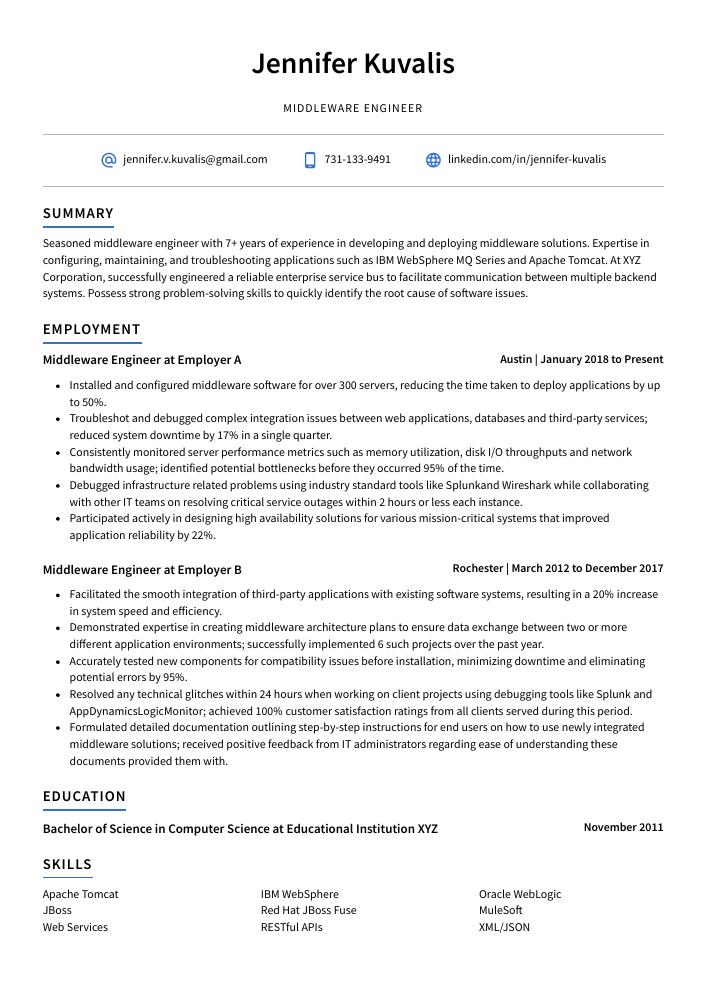Middleware Engineer Resume Guide
Middleware engineers develop and maintain software that connects multiple applications or services together. They work with a variety of programming languages, databases, operating systems and networks to ensure the different components are able to communicate effectively. Middleware engineers also troubleshoot any issues related to data transmission between applications or services, as well as design new integration solutions for their clients.
Your expertise in middleware engineering is unmatched. But potential employers don’t know who you are and why they should hire you. To make them aware of your skills and experience, a resume that captures their attention is essential.
This guide will walk you through the entire process of creating a top-notch resume. We first show you a complete example and then break down what each resume section should look like.
Table of Contents
The guide is divided into sections for your convenience. You can read it from beginning to end or use the table of contents below to jump to a specific part.
Middleware Engineer Resume Sample
Jennifer Kuvalis
Middleware Engineer
[email protected]
731-133-9491
linkedin.com/in/jennifer-kuvalis
Summary
Seasoned middleware engineer with 7+ years of experience in developing and deploying middleware solutions. Expertise in configuring, maintaining, and troubleshooting applications such as IBM WebSphere MQ Series and Apache Tomcat. At XYZ Corporation, successfully engineered a reliable enterprise service bus to facilitate communication between multiple backend systems. Possess strong problem-solving skills to quickly identify the root cause of software issues.
Experience
Middleware Engineer, Employer A
Austin, Jan 2018 – Present
- Installed and configured middleware software for over 300 servers, reducing the time taken to deploy applications by up to 50%.
- Troubleshot and debugged complex integration issues between web applications, databases and third-party services; reduced system downtime by 17% in a single quarter.
- Consistently monitored server performance metrics such as memory utilization, disk I/O throughputs and network bandwidth usage; identified potential bottlenecks before they occurred 95% of the time.
- Debugged infrastructure related problems using industry standard tools like Splunkand Wireshark while collaborating with other IT teams on resolving critical service outages within 2 hours or less each instance.
- Participated actively in designing high availability solutions for various mission-critical systems that improved application reliability by 22%.
Middleware Engineer, Employer B
Rochester, Mar 2012 – Dec 2017
- Facilitated the smooth integration of third-party applications with existing software systems, resulting in a 20% increase in system speed and efficiency.
- Demonstrated expertise in creating middleware architecture plans to ensure data exchange between two or more different application environments; successfully implemented 6 such projects over the past year.
- Accurately tested new components for compatibility issues before installation, minimizing downtime and eliminating potential errors by 95%.
- Resolved any technical glitches within 24 hours when working on client projects using debugging tools like Splunk and AppDynamicsLogicMonitor; achieved 100% customer satisfaction ratings from all clients served during this period.
- Formulated detailed documentation outlining step-by-step instructions for end users on how to use newly integrated middleware solutions; received positive feedback from IT administrators regarding ease of understanding these documents provided them with.
Skills
- Apache Tomcat
- IBM WebSphere
- Oracle WebLogic
- JBoss
- Red Hat JBoss Fuse
- MuleSoft
- Web Services
- RESTful APIs
- XML/JSON
Education
Bachelor of Science in Computer Science
Educational Institution XYZ
Nov 2011
Certifications
Oracle Certified Professional, Middleware Administrator
Oracle Certification Program
May 2017
1. Summary / Objective
Your resume summary is your chance to make a great first impression on the hiring manager. It should be concise and provide an overview of who you are as a middleware engineer, including your experience with various platforms and technologies. For example, you could mention how many years of experience you have in this field, any certifications or awards that demonstrate your expertise in middleware engineering, and the successful projects you’ve completed for clients.
Below are some resume summary examples:
Dependable and enthusiastic Middleware Engineer with 5+ years of experience in designing, building, and maintaining middleware systems for enterprise applications. Highly experienced in setting up the necessary infrastructure for integration solutions such as web services and message-oriented middleware (MOM). Proven ability to develop scripts to automate processes, allowing organizations to quickly adapt their IT landscape according to changing needs.
Energetic middleware engineer with 8+ years of experience in designing and implementing middleware solutions. Experienced in deploying, maintaining, and troubleshooting IBM WebSphere MQ Series infrastructure. Skilled at creating integrations between various applications using web services like SOAP/REST API’s and ESB (Enterprise Service Bus). Proven success managing projects from initial design through to deployment and support.
Hard-working and motivated middleware engineer with 7+ years of experience developing and testing enterprise-grade applications. Specializing in integrating, optimizing, and troubleshooting distributed systems using Java/J2EE technologies. At XYZ Corp., successfully implemented a custom middleware solution that improved system performance by 70%. Seeking to join ABC Tech as the next Middleware Engineer on their team.
Passionate middleware engineer with 5+ years of experience developing, managing and maintaining middleware systems. Skilled in troubleshooting and problem solving to ensure reliable tools for clients. At XYZ Inc., improved system performance by 22% through the introduction of new technologies such as Kafka Streams and Apache Spark Streaming. Looking to bring my expertise to ABC Tech’s innovative team of engineers.
Accomplished middleware engineer with 8+ years of experience in designing, developing, and maintaining enterprise-level middleware applications. Skilled at integrating systems for optimal performance and scalability. Currently looking to join ABC Tech as a Middleware Engineer to leverage expertise in building robust solutions that meet customer needs while ensuring the highest levels of reliability and security.
Reliable middleware engineer with 3+ years of experience in designing and developing middleware solutions. Proven track record of successful integration projects using leading industry tools, such as Oracle Fusion Middleware, Apache Camel, and RabbitMQ. Seeking to join ABC Tech to leverage my expertise for delivering high-quality software solutions with an emphasis on scalability and performance optimization.
Enthusiastic middleware engineer with 7+ years of experience in developing and deploying robust middleware applications. Expertise in configuring, managing, troubleshooting, testing & implementing various Oracle Fusion Middleware technologies such as WebLogic Server and SOA Suite. Proven ability to successfully integrate complex systems using messaging services such as MQ Series & TIBCO EMS.
Amicable and tenacious middleware engineer with 4+ years of experience designing and building applications. Experienced in working with a variety of technologies, including Java, J2EE, Spring Boot, and Oracle Database. Seeking to leverage my technical skillset for the benefit of ABC’s innovative projects while delivering successful projects on time and within budget.
2. Experience / Employment
For the experience section, you should list your work history in reverse chronological order, with the most recent job listed first.
When writing about what you did for each role, use bullet points to make it easier for the reader to take in all of the information quickly. You want to be as specific and detailed as possible when describing what tasks you completed and any results that were achieved due to your efforts.
For example, instead of saying “Developed middleware applications,” you could say, “Created four custom middleware applications using Java EE technologies which enabled a 10% increase in system performance.”
To write effective bullet points, begin with a strong verb or adverb. Industry specific verbs to use are:
- Configured
- Monitored
- Implemented
- Optimized
- Automated
- Troubleshot
- Resolved
- Developed
- Installed
- Administered
- Analyzed
- Upgraded
- Tested
- Debugged
- Deployed
Other general verbs you can use are:
- Achieved
- Advised
- Assessed
- Compiled
- Coordinated
- Demonstrated
- Expedited
- Facilitated
- Formulated
- Improved
- Introduced
- Mentored
- Participated
- Prepared
- Presented
- Reduced
- Reorganized
- Represented
- Revised
- Spearheaded
- Streamlined
- Structured
- Utilized
Below are some example bullet points:
- Assessed the performance of enterprise middleware platforms, identified opportunities for improvement and implemented solutions that increased system availability by 25%.
- Confidently administered application servers using IBM WebSphere Application Server (WAS), Tomcat and JBoss technologies; configured web services to integrate with multiple backend systems.
- Administered Oracle Databases including creating tables, views, packages & triggers in PL/SQL; optimized databases queries for improved speed & accuracy resulting in 10% increase in productivity.
- Mentored junior team members on best practices related to the installation, configuration and management of middleware applications such as Apache HTTP Server 2+, Oracle Tuxedo 12c+ and BEA Weblogic 11g+.
- Revised architecture designs based on customer requirements while adhering to industry standards; successfully completed 5 projects across a wide range of infrastructures within tight deadlines.
- Reduced system downtime by 30% and resolved complex production issues with middleware components within an average of 2 hours.
- Developed, tested, and deployed integrated solutions between enterprise applications using a variety of integration technologies such as Web Services, Service Bus & ESB Platforms.
- Structured data access methods to store/retrieve information from backend databases; improved query performance by 25%.
- Implemented web services security policies in the organization’s WSO2 stack architecture; increased customer application response time by 40%.
- Substantially reduced operating costs associated with maintenance activities thanks to timely patch updates for middleware installations and configurations on multiple platforms (Linux/Windows).
- Upgraded middleware components for over 50 applications, reducing system downtime by 30% and increasing customer satisfaction levels.
- Monitored middleware platform performance on a continual basis to quickly diagnose & resolve any technical issues in order to maintain 100% uptime availability.
- Coordinated with multiple stakeholders across various departments including development, operations, QA and management teams to ensure successful implementation of new integrations within the established timelines.
- Represented the organization at external forums such as conferences & industry events; shared knowledge & best practices related to middleware systems with fellow engineers from other companies in attendance.
- Actively participated in troubleshooting escalations involving integration-related problems that arose during deployment or production stages; resolved over 80 incidents within 24 hours each month while ensuring no additional expenses incurred due to extended service outages or delays caused by these issues.
- Efficiently deployed middleware solutions to over 500 servers within 3 months, resulting in a 25% increase in system performance.
- Tested and troubleshot multiple production systems using debugging tools such as Splunk and AppDynamics; identified problems quickly and resolved them within 1-2 hours on average.
- Utilized scripting languages like Python, Java & Bash to automate processes that expedited the deployment of applications from development environment into production by 50%.
- Analyzed server logs regularly to identify issues with existing middleware components; developed new strategies for better resource management which improved scalability by 15%.
- Expedited process of patching hundreds of endpoints each month through creating scripts utilizing Ansible automation framework; managed security updates successfully at all times without any downtime or service disruption incidents reported during the period covered.
- Automated the upgrade of middleware components across a wide range of applications, resulting in an increase in system performance by 30%.
- Advised and trained colleagues on the proper usage of middleware technologies; provided comprehensive helpdesk support to over 200 users every month.
- Proficiently used Java Application Servers, Web Services and XML tools such as SOAP/RESTful web services for secure data transmission between integrated systems.
- Presented technical solutions to stakeholders at business review meetings with an aim to improve operational efficiency; saved $15,000 through cost-effective implementations last year alone.
- Prepared detailed documentation including deployment steps & best practices for maintaining all server configurations and environments; reduced troubleshooting time from 10 hours per incident to 4 hours on average within 6 months period.
- Improved uptime and reliability of middleware platforms by 40% through proactive monitoring, troubleshooting and performance tuning.
- Spearheaded the deployment of new enterprise-level APIs in 5+ projects; successfully integrated various back-end systems with customer facing applications for improved scalability & usability across multiple platforms.
- Configured, managed and maintained over 50 web servers running on Linux/UNIX operating systems to ensure all services ran smoothly without any impact to customers or other stakeholders.
- Reliably delivered high quality software solutions using technologies such as Java EE, JBoss EAP 7+, Apache Tomcat 8+ & Oracle WebLogic 12c+.
- Streamlined middleware development process while ensuring compatibility between application components by leveraging DevOps tools such as GIT / SVN repositories, Jenkins CI pipelines etc., reducing time spent on debugging by 25%.
- Deployed and maintained 10+ middleware applications for medium to large-scale businesses, achieving a 95% uptime rate.
- Introduced new middleware solutions that enabled the consolidation of over 50 services, reducing operational costs by $10K per month and enhancing data security in the process.
- Reorganized existing client databases and migrated them onto more secure platforms with minimal downtime; generated savings of up to 20%.
- Achieved cost efficiencies by automating processes through scripting tasks using languages such as Python and JavaScript, resulting in an average reduction of 40 hours/month on manual labor operations across all departments within the organization.
- Independently designed an integrated system architecture that incorporated cloud computing elements into legacy systems while ensuring scalability & flexibility without compromising performance or stability levels – increased customer satisfaction ratings by 25%.
3. Skills
Even though two organizations are hiring for the same role, the skillset they want an ideal candidate to possess could differ significantly. For instance, one may be on the lookout for an individual who is proficient in Apache Kafka while another may prefer someone who has hands-on experience with RabbitMQ.
It is important to tailor the skills section of your resume for each job you are applying for, as many employers now use applicant tracking systems that scan resumes for certain keywords before passing them on to a human.
Once listed here, it would be wise to elaborate further on these skillset by discussing it in more detail within other sections such as the summary or experience section.
Below is a list of common skills & terms:
- Apache Tomcat
- IBM WebSphere
- JBoss
- Message-oriented Middleware (MOM)
- MuleSoft
- Oracle WebLogic
- RESTful APIs
- Red Hat JBoss Fuse
- Web Services
- XML/JSON
4. Education
Including an education section on your resume will depend on how far along you are in your career. If you just graduated and have no work experience, your education should be mentioned below your resume objective. However, if you have significant work experience to showcase, an education section may not be necessary at all.
If an education section is included, try to mention courses related to the middleware engineer role such as software engineering or computer science that can demonstrate relevant knowledge for the position.
Bachelor of Science in Computer Science
Educational Institution XYZ
Nov 2011
5. Certifications
Certifications are a great way to demonstrate your proficiency in a particular field or skill. They can help you stand out from other applicants and show potential employers that you are knowledgeable and committed to staying up-to-date with industry trends.
Including certifications on your resume is an excellent way of showing that you have the necessary skills for the job, as well as highlighting any additional qualifications which may be beneficial for the role.
Oracle Certified Professional, Middleware Administrator
Oracle Certification Program
May 2017
6. Contact Info
Your name should be the first thing a reader sees when viewing your resume, so ensure its positioning is prominent. Your phone number should be written in the most commonly used format in your country/city/state, and your email address should be professional.
You can also choose to include a link to your LinkedIn profile, personal website, or other online platforms relevant to your industry.
Finally, name your resume file appropriately to help hiring managers; for Jennifer Kuvalis, this would be Jennifer-Kuvalis-resume.pdf or Jennifer-Kuvalis-resume.docx.
7. Cover Letter
Providing a cover letter when applying for a job is an effective way to introduce yourself and explain why you’re the right fit. It should be made up of 2 to 4 paragraphs separate from your resume, making it easier for recruiters to get a better understanding of who you are as a professional.
Cover letters don’t always need to be included with every application but they can give hiring managers more insight into what makes you unique. Plus, including one could help set your application apart from other applicants competing for the same role!
Below is an example cover letter:
Dear Lina,
I am interested in the Middleware Engineer position at XYZ Corporation. With more than 10 years of experience designing, developing, and implementing middleware solutions, I offer a solid background in this field. My attached resume provides additional details regarding my skills and accomplishments.
As you will see from my resume, I have gained considerable experience working with various middleware platforms such as WebSphere MQ, TIBCO EMS/BW, Sonic ESB/ESP, and Oracle Fusion Middleware (SOA Suite). In addition to my technical expertise, I also possess strong analytical and problem-solving skills that have allowed me to successfully troubleshoot complex issues.
In previous roles, I have been responsible for leading project teams and providing mentorship to junior staff members. I am confident in my ability to manage projects from start to finish while ensuring that all deadlines are met. Furthermore, I possess excellent communication skills that allow me to effectively interface with both technical and non-technical staff members.
I would welcome the opportunity to discuss how my qualifications can best benefit your organization. Please contact me at your earliest convenience so that we can arrange a time for a meeting or phone conversation. Thank you for your time and consideration; I look forward to speaking with you soon!
Sincerely,
Jennifer
Middleware Engineer Resume Templates
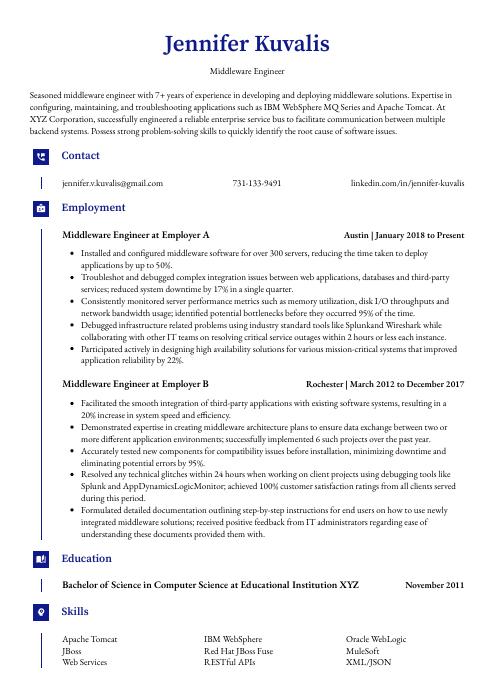 Gharial
Gharial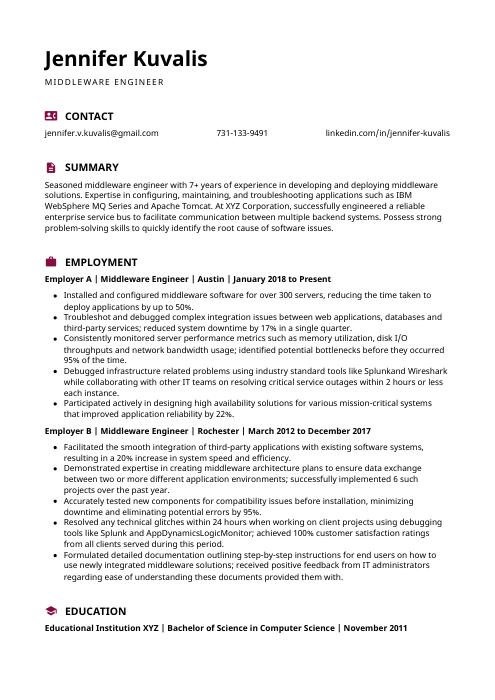 Hoopoe
Hoopoe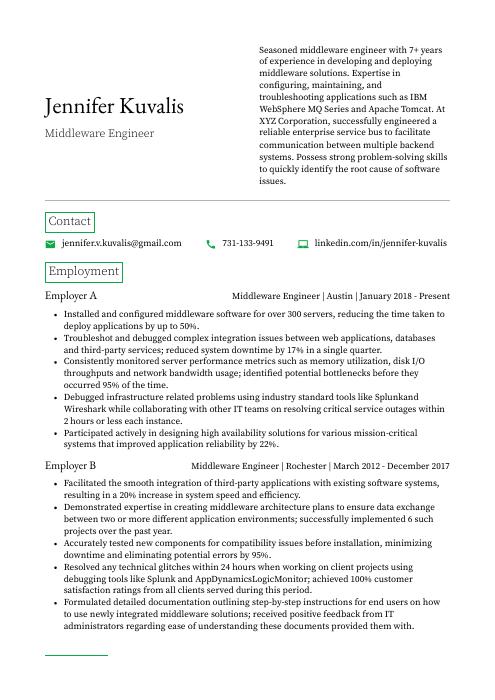 Quokka
Quokka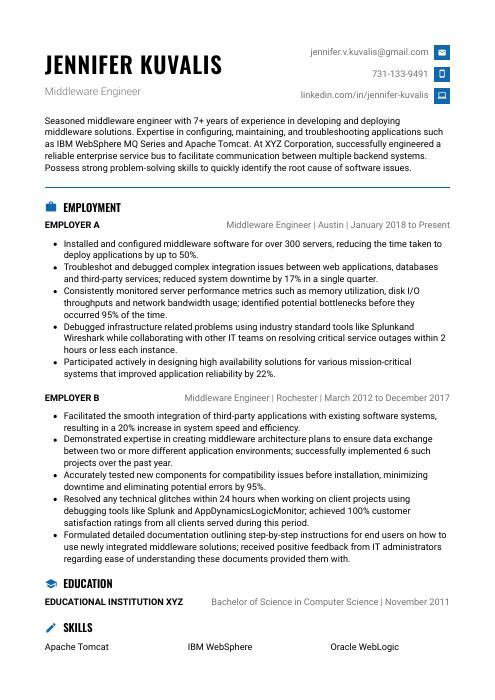 Echidna
Echidna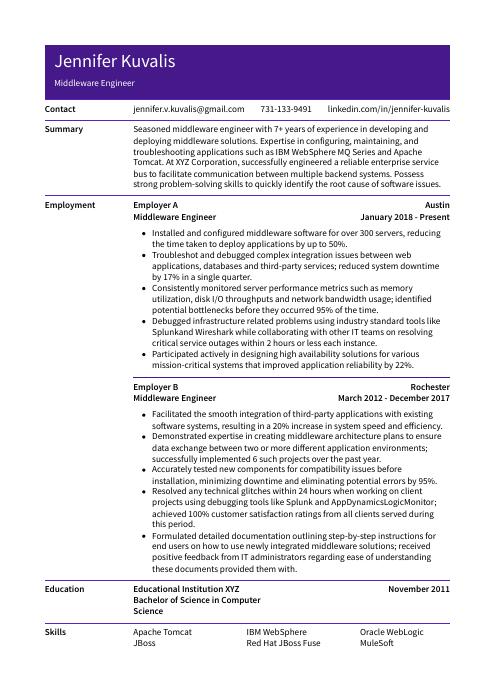 Pika
Pika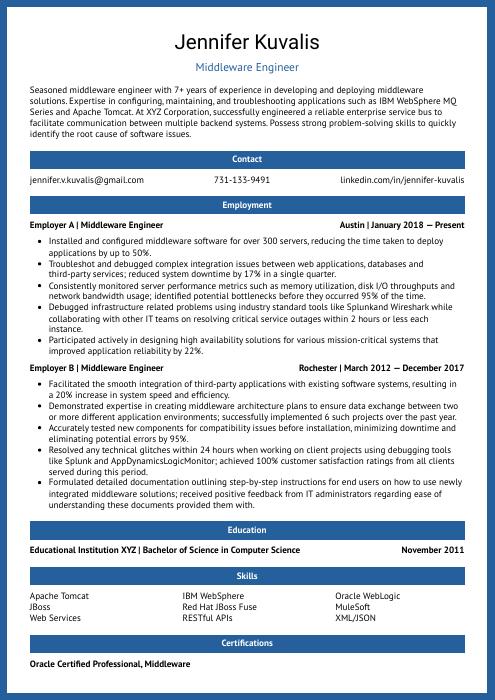 Ocelot
Ocelot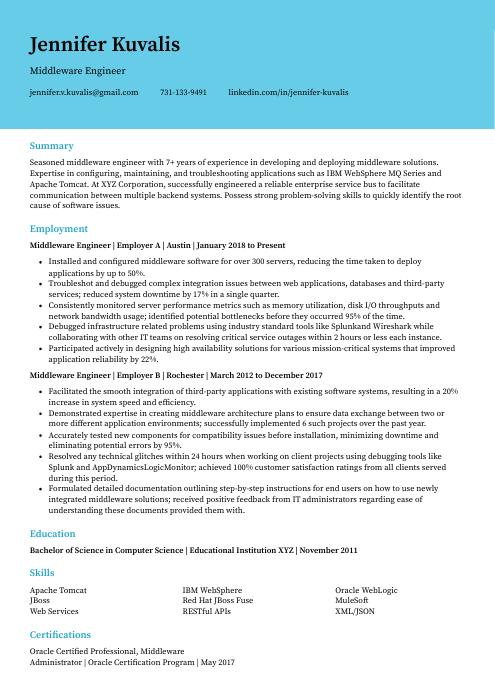 Dugong
Dugong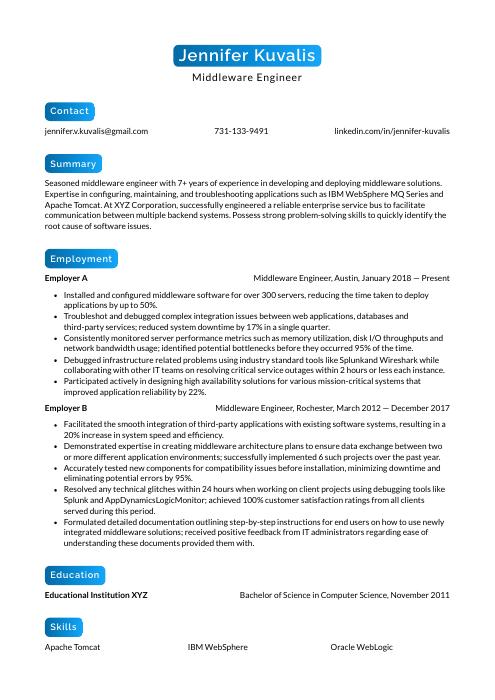 Kinkajou
Kinkajou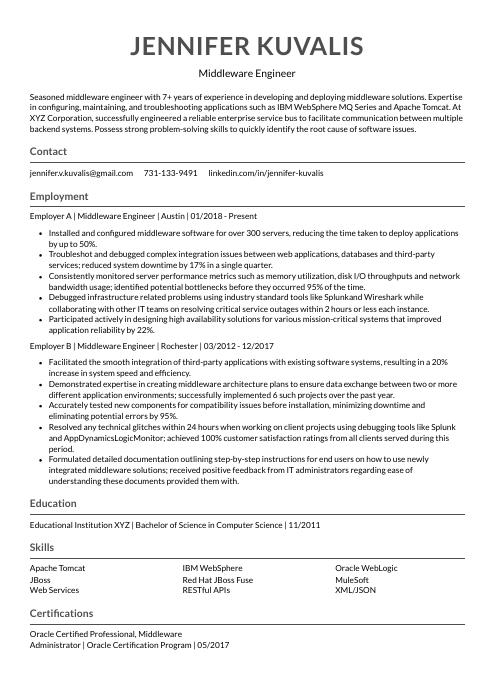 Indri
Indri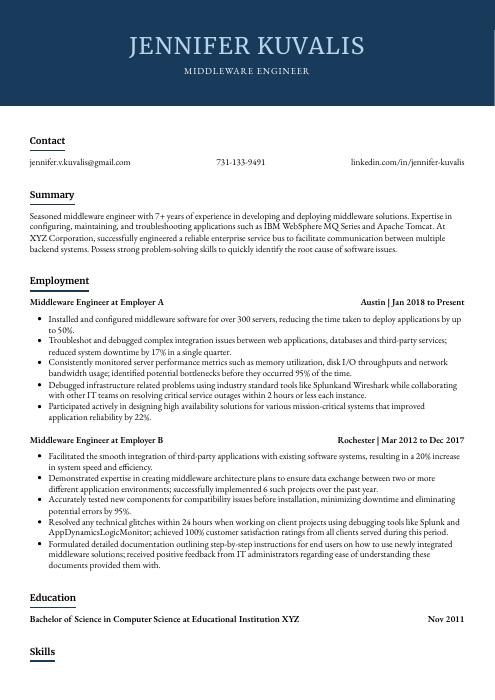 Bonobo
Bonobo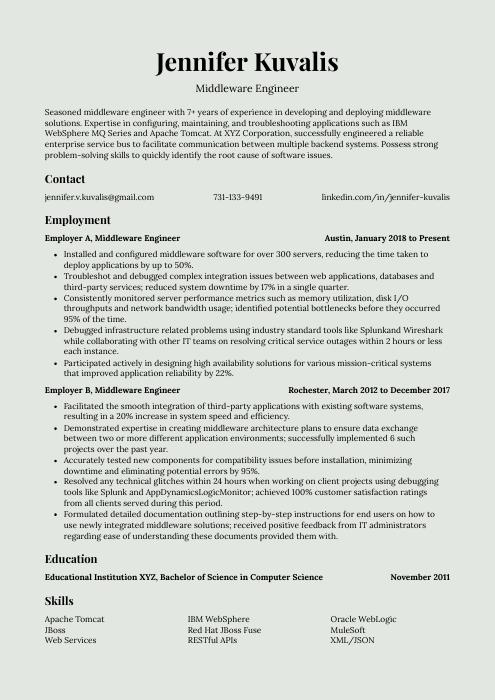 Saola
Saola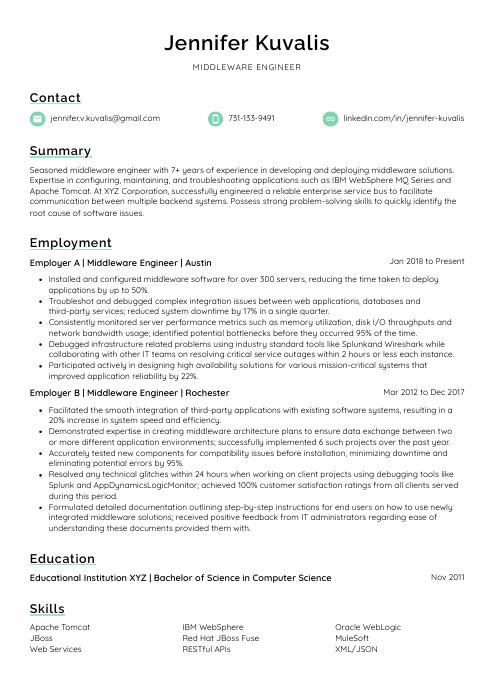 Lorikeet
Lorikeet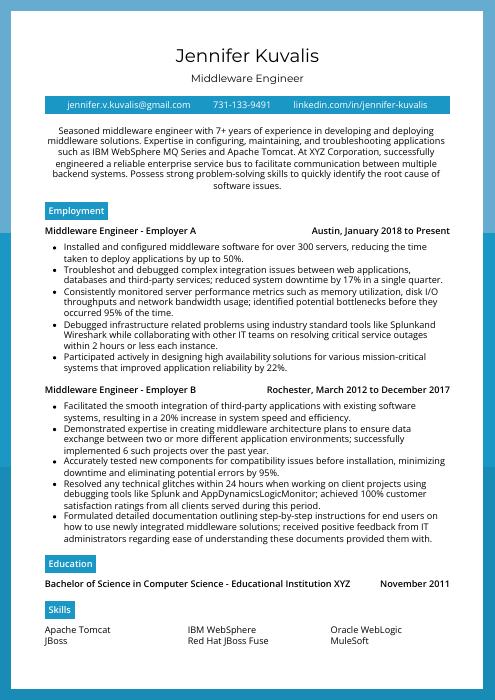 Rhea
Rhea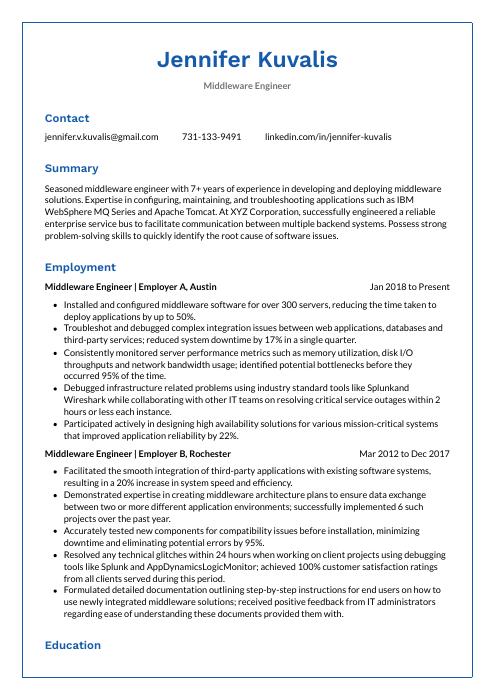 Markhor
Markhor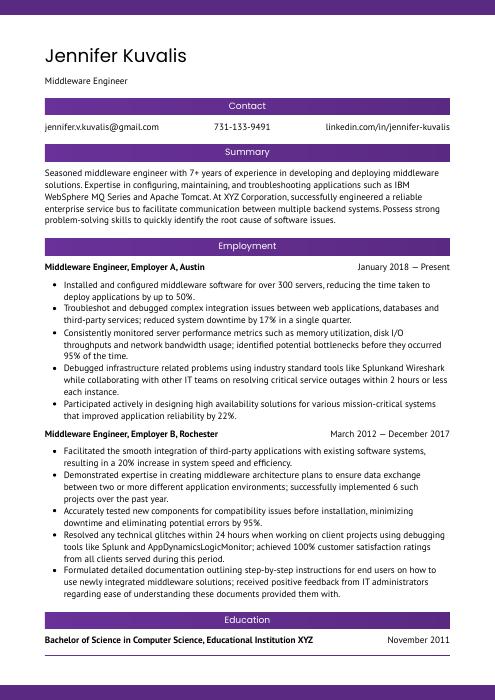 Jerboa
Jerboa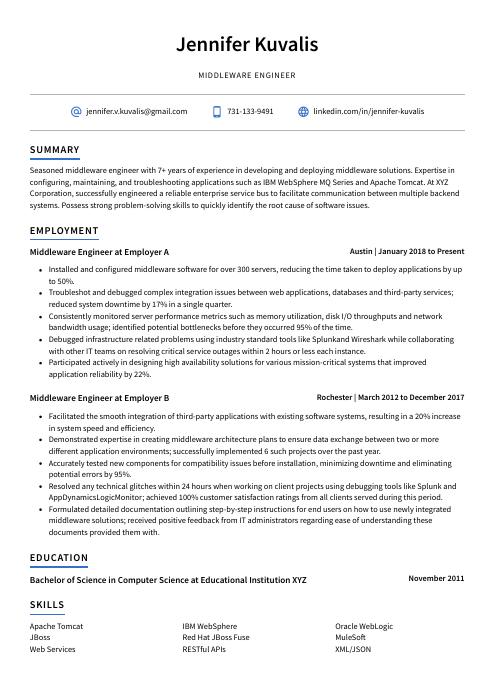 Axolotl
Axolotl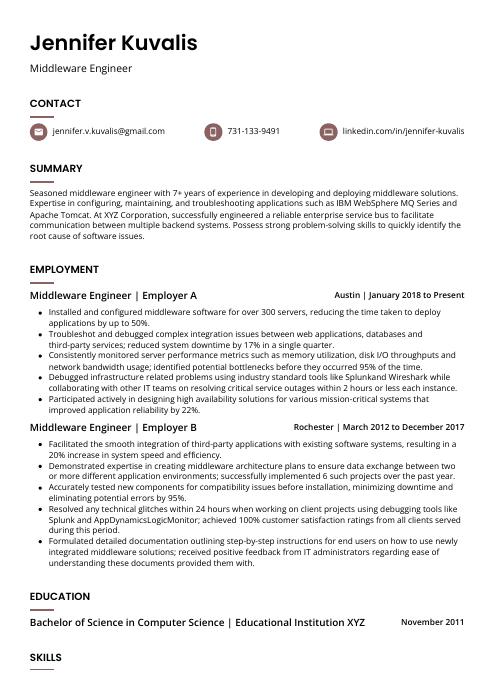 Fossa
Fossa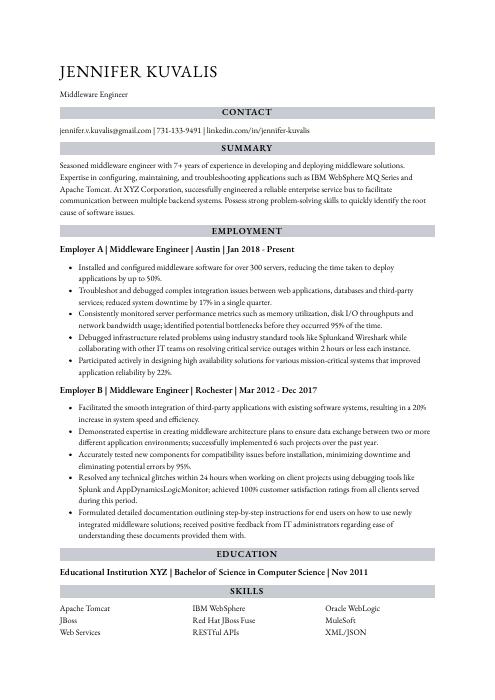 Numbat
Numbat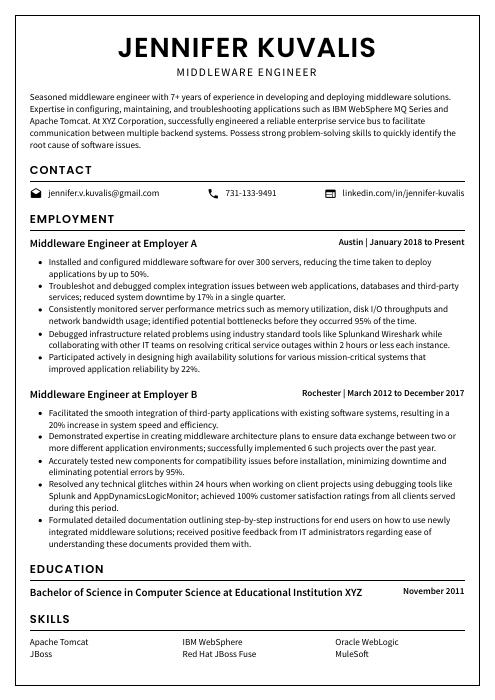 Cormorant
Cormorant Rezjumei
Rezjumei
